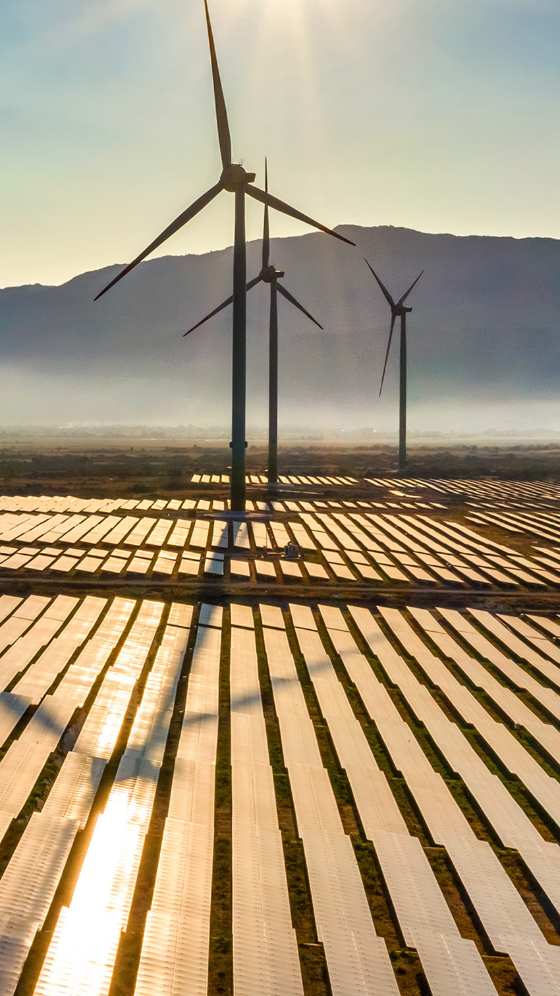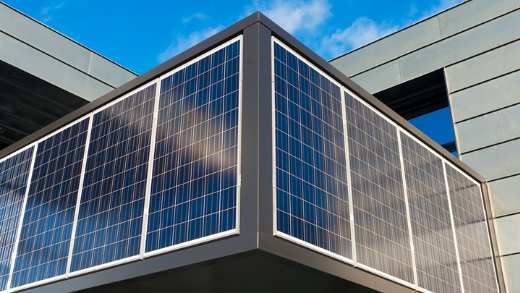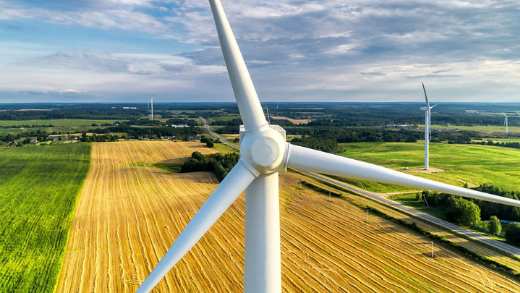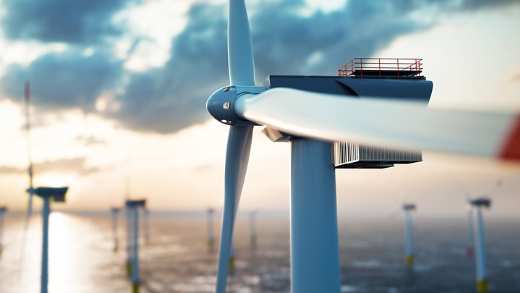In this Q&A, James Tarry and Luke Layfield explore the themes shaping the landscape for real asset investors with a climate transition focus.
Read this article to understand:
- How the higher-for-longer rates environment could create real estate opportunities in 2024
- Three global megatrends in renewable-energy infrastructure
- The investment and climate benefits of nature-based solutions
As government officials, corporate executives and climate scientists convened in Dubai’s air-conditioned conference halls for the COP28 summit, media attention was focused on the high-level policy agreements that could steer a path to a low-emissions future.
When it comes to the finer detail, much of the work of decarbonising major economies will need to happen in the built environment. Recognising real estate and infrastructure are significant contributors to global carbon emissions, investors are already taking advantage of opportunities to renovate inefficient property and create lower-carbon energy, digital and transport networks. Nature-based solutions that can trap carbon from the atmosphere, such as forestry schemes, are increasingly in demand.
Faster progress is needed, however, and the uncertain macroeconomic backdrop is creating short-term challenges. High inflation has rendered redevelopment projects more expensive and elevated interest rates have put borrowers under pressure, leading to a sharp repricing of real estate in some markets.
But the longer-term structural trends remain positive. Those who can invest directly and exert control over the emissions profile of their assets could make a tangible difference on climate while achieving attractive investment returns and portfolio diversification.
James Tarry (JT) and Luke Layfield (LL), co-managers of Aviva Investors’ Climate Transition Real Assets strategy, sat down with AIQ to discuss their outlook for 2024.
2023 was the hottest year on record.1 To what extent are inefficient real estate and infrastructure fuelling the climate crisis and how can investors in real assets make a tangible difference?
LL: Real estate and infrastructure are major factors in the crisis – according to Architecture 2030, a think tank, the built environment accounts for 42 per cent of global emissions.2 The flip side of that is direct investors in these sectors can make a significant difference by transitioning assets.
Targeted investment in real assets can help avoid, reduce and remove carbon emissions: avoiding carbon emissions through financing renewable-energy networks and other infrastructure; reducing emissions through decarbonising property; and removing emissions through nature-based solutions, such as afforestation projects.
Global markets have been roiled by an aggressive monetary tightening cycle and geopolitical tensions over the past two years. How has the uncertain macroeconomic landscape affected real assets in the UK and Europe, and do you expect the picture to change in 2024?
LL: The major theme in 2023 was the big structural shift in interest rates, a function of inflation being higher and more persistent than expected. For real assets, that has led to a repricing in line with the shift in rates, but also low transaction volumes, particularly in real estate due to pricing uncertainty. The rise in construction costs has also curtailed new development.
Risk premia remain compressed and we attribute that to the continuing strength of demand for green assets
Infrastructure equity assets have been much slower to reprice than real estate. Most recent transactions have been in the renewables sector, where substantial capital continues to be raised. Although we saw some repricing in infrastructure equity in the fourth quarter, risk premia remain compressed and we attribute that to the continuing strength of demand for renewables.
Overall infrastructure transaction volumes were down around 20 per cent year-on-year as of December 2023, which is less than might have been expected given the challenging macroeconomic context.
JT: Looking ahead, it seems as though high rates are having the intended effect, with weaker jobs and inflation data coming through in some economies and markets pricing the end of the rate-hiking cycle in 2024.
More important from our perspective, rates are expected to remain elevated for some time. Central banks will be wary of inflation returning, and this could create an attractive entry point for some real asset markets. For example, we are starting to see forced selling in real estate as a result of refinancing deals having to occur at elevated loan-to-value ratios, and investors with dry power could take advantage.
Which sectors might offer opportunities in 2024?
JT: We expect greater differentiation by asset fundamentals, resulting in a “K-shaped” recovery in real estate, with prime assets recovering at increasing speed and secondary assets lagging. The living, logistics and prime office sectors have strong fundamentals and should perform particularly well thanks to robust occupier markets.
Infrastructure aligned to the climate transition has a persistent tailwind across locations
Infrastructure aligned to the climate transition has a persistent tailwind across locations; that has been the case for some time. But the outlook varies by sector. Take digital infrastructure, such as fibre broadband: fibre is three times more energy-efficient than copper and its speed enables people to work remotely rather than commute into the office, which helps mitigate transport-related emissions. We expect further consolidation in that market in 2024, with the strongest groups getting stronger and weaker rivals being acquired or falling away. By comparison, the electric-vehicle (EV) infrastructure market is still nascent and the leading providers should continue to attract capital.
One intriguing development is the growth in decentralised energy production and efficiency solutions. We see opportunities to invest in providing power for residential and corporate tenants at a local level, through renewable-energy generation, battery storage and energy-efficiency measures. This theme will start to attract more attention in 2024.
What are the longer-term themes shaping infrastructure sectors and how are we responding to them?
JT: We are seeing the emergence of three global megatrends in infrastructure as the world responds to decarbonisation challenges. The first relates to the energy transition and encompasses growing demand for renewable assets such as windfarms and solar power but also energy storage, biogas and hydrogen.
We believe structural tailwinds will continue to support these sectors over the longer term
The second relates to the decarbonisation of transportation, with EV-charging networks and electric buses likely to play a key role. Third is digital infrastructure, where electrification and the growth of smart technologies should benefit fibre broadband, data centres and telecommunications towers.
While we are wary of the risks – particularly around planning bottlenecks for new projects – we believe structural tailwinds will continue to support these sectors over the longer term.
Are the incentives provided by the US and EU on clean tech opening up any opportunities to invest in early-stage companies developing low-carbon technologies?
LL: Exposure to early-stage climate technologies through private-market investments can create opportunities for financial returns and diversification, but also new solutions that could enable us to accelerate the decarbonisation of our own portfolios. From smart EV chargers to solar panels that produce potable water from the atmosphere, there are exciting innovations investors can access via an allocation to venture-capital (VC) funds.
There are exciting innovations investors can access via an allocation to venture-capital (VC) funds
The US Inflation Reduction Act earmarks $370 billion of subsidies and tax breaks for low-carbon industries. This is already “bending the cost curve” and should lead to faster growth and adoption for cutting-edge climate tech. The proposed EU Net Zero Industry Act has been touted as a European equivalent, although the scale of the support is likely to be much smaller, with a focus on amending state-aid rules as opposed to directly providing new capital.3
In the UK, the Mansion House Compact, under which nine of the UK’s largest defined-contribution (DC) pension schemes (including Aviva) have agreed to allocate five per cent of their portfolios to private equity – potentially unlocking £75 billion of capital – could provide a further boost to early-stage technology sectors.4
One way to reduce emissions is to improve the energy efficiency of buildings. What are the characteristics that make an asset a good candidate for this kind of redevelopment?
LL: There is a compelling investment case for upgrading assets in this way. Climate-aligned real estate should benefit from a “green premium” thanks to increasing demand for modern, comfortable buildings that help tenants meet their own climate targets and reduce costs (energy-efficient property is cheaper to run). This is important in the context of the transition – by some estimates, 80 per cent of buildings that will exist in 2050 have already been built, so we must curb the emissions of existing stock where possible.5
But not all buildings are good candidates. It is important to avoid taking on too much additional location or market risk when embarking on a redevelopment. We exclusively focus on opportunities in the UK and Western Europe for this reason, favouring tired or obsolete assets in locations with strong local supply-and-demand fundamentals. For example, we are redeveloping Curtain House, a Victorian warehouse in East London, to create a modern office building that should benefit from its proximity to a key cluster for creative industries in the UK capital.
What role do nature-based solutions play in real assets portfolios? And how does direct investment compare with buying carbon credits?
JT: It can be difficult to access high-quality carbon credits, particularly in the UK, where supply is limited. And rising demand is making carbon allowances, such as those available under the European Union’s Emissions Trading System (ETS), more expensive.
Rising demand is making carbon allowances more expensive
This means investing in afforestation projects directly can be advantageous. We have made two investments in Scotland – Glen Dye Moor in Aberdeenshire, where we will be planting 5,000,000 trees and undertaking the restoration of 1,800 hectares of peatland, and Glen Forsa, where we'll be afforesting 1,500 hectares – which should contribute a cumulative 350,000 tonnes of carbon removal by 2040.
In doing so, we hope to keep our cost of carbon production down to around $15 per tonne; by comparison, the regulated price of EU carbon allowances hit €100 per tonne in 2023.6 This should allow us to both address residual carbon emissions from our portfolios and hedge against rising carbon prices.



















